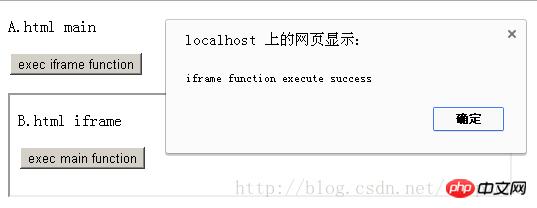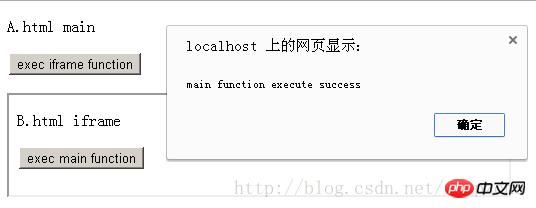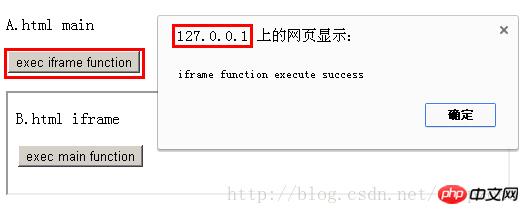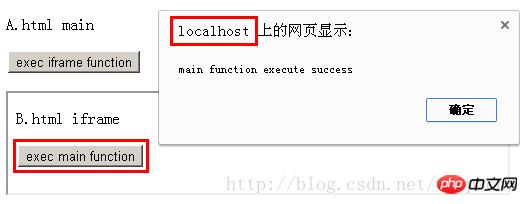 Web Front-end
Web Front-end
 JS Tutorial
JS Tutorial
 Introduction to cross-domain mutual access methods between iframe and main frame
Introduction to cross-domain mutual access methods between iframe and main frame
Introduction to cross-domain mutual access methods between iframe and main frame
Today I just need to use the implementation method of mutual access between iframe and main frame. I happened to see this article. It is really good. I would like to share it. Friends who need it can refer to it
1. Same Mutual access between domains
Assume that A.html and b.html domains are both localhost (same domain)
The iframe in A.html is embedded in B.html, name=myframe
A.html There is js function fMain()
B.html has js function fIframe()
It is necessary to implement A.html to call fIframe() of B.html, and B.html to call fMain() of A.html
A.html
<!DOCTYPE HTML PUBLIC "-//W3C//DTD HTML 4.01 Transitional//EN" "http://www.w3.org/TR/html4/loose.dtd">
<html>
<head>
<meta http-equiv="content-type" content="text/html; charset=utf-8">
<title> main window </title>
<script type="text/javascript">
// main js function
function fMain(){
alert('main function execute success');
}
// exec iframe function
function exec_iframe(){
window.myframe.fIframe();
}
</script>
</head>
<body>
<p>A.html main</p>
<p><input type="button" value="exec iframe function" onclick="exec_iframe()"></p>
<iframe src="B.html" name="myframe" width="500" height="100"></iframe>
</body>
</html>B.html
##
<!DOCTYPE HTML PUBLIC "-//W3C//DTD HTML 4.01 Transitional//EN" "http://www.w3.org/TR/html4/loose.dtd">
<html>
<head>
<meta http-equiv="content-type" content="text/html; charset=utf-8">
<title> iframe window </title>
<script type="text/javascript">
// iframe js function
function fIframe(){
alert('iframe function execute success');
}
// exec main function
function exec_main(){
parent.fMain();
}
</script>
</head>
<body>
<p>B.html iframe</p>
<p><input type="button" value="exec main function" onclick="exec_main()"></p>
</body>
</html>A.html exec iframe function button, the execution is successful, and iframe function execute success pops up. As shown below

B.html , the execution is successful, and main function execute success pops up. As shown below

2. Cross-domain mutual access
Assume that A.html domain is localhost and B.html domain is 127.0. 0.1 (cross-domain)The localhost and 127.0.0.1 are used here just to facilitate testing. Localhost and 127.0.0.1 are already in different domains, so the execution effect is the same.
In actual use, just change to www.domaina.com and www.domainb.com.
The iframe in A.html is embedded in B.html, name=myframe
A.html has js function fMain()
B.html has js function fIframe()
Need to implement A.html to call B .html's fIframe(), B.html calls A.html's fMain() (cross-domain call)
Uncaught SecurityError: Blocked a frame with origin "http://localhost" from accessing a frame with origin "http://127.0.0.1". Protocols, domains, and ports must match.
Implementation principle:
Because the browser prohibits access from different domains for security reasons. Therefore, as long as the calling and executing parties are in the same domain, they can access each other. First, how does A.html call the fIframe method of B.html1. Create an iframe in A.html
2. Place the iframe page under the same domain as B.html and name it execB.html
3.execB.html contains the js call that calls the fIframe method of B.html
<script type="text/javascript"> parent.window.myframe.fIframe(); // execute parent myframe fIframe function </script>
execA.html in the same domain as A.html to call the A.html fMain method. js call
<script type="text/javascript"> parent.parent.fMain(); // execute main function </script>
<!DOCTYPE HTML PUBLIC "-//W3C//DTD HTML 4.01 Transitional//EN" "http://www.w3.org/TR/html4/loose.dtd">
<html>
<head>
<meta http-equiv="content-type" content="text/html; charset=utf-8">
<title> main window </title>
<script type="text/javascript">
// main js function
function fMain(){
alert('main function execute success');
}
// exec iframe function
function exec_iframe(){
if(typeof(exec_obj)=='undefined'){
exec_obj = document.createElement('iframe');
exec_obj.name = 'tmp_frame';
exec_obj.src = 'http://127.0.0.1/execB.html';
exec_obj.style.display = 'none';
document.body.appendChild(exec_obj);
}else{
exec_obj.src = 'http://127.0.0.1/execB.html?' + Math.random();
}
}
</script>
</head>
<body>
<p>A.html main</p>
<p><input type="button" value="exec iframe function" onclick="exec_iframe()"></p>
<iframe src="http://127.0.0.1/B.html" name="myframe" width="500" height="100"></iframe>
</body>
</html><!DOCTYPE HTML PUBLIC "-//W3C//DTD HTML 4.01 Transitional//EN" "http://www.w3.org/TR/html4/loose.dtd">
<html>
<head>
<meta http-equiv="content-type" content="text/html; charset=utf-8">
<title> iframe window </title>
<script type="text/javascript">
// iframe js function
function fIframe(){
alert('iframe function execute success');
}
// exec main function
function exec_main(){
if(typeof(exec_obj)=='undefined'){
exec_obj = document.createElement('iframe');
exec_obj.name = 'tmp_frame';
exec_obj.src = 'http://localhost/execA.html';
exec_obj.style.display = 'none';
document.body.appendChild(exec_obj);
}else{
exec_obj.src = 'http://localhost/execA.html?' + Math.random();
}
}
</script>
</head>
<body>
<p>B.html iframe</p>
<p><input type="button" value="exec main function" onclick="exec_main()"></p>
</body>
</html>
<!DOCTYPE HTML PUBLIC "-//W3C//DTD HTML 4.01 Transitional//EN" "http://www.w3.org/TR/html4/loose.dtd"> <html> <head> <meta http-equiv="content-type" content="text/html; charset=utf-8"> <title> exec main function </title> </head> <body> <script type="text/javascript"> parent.parent.fMain(); // execute main function </script> </body> </html>
<!DOCTYPE HTML PUBLIC "-//W3C//DTD HTML 4.01 Transitional//EN" "http://www.w3.org/TR/html4/loose.dtd"> <html> <head> <meta http-equiv="content-type" content="text/html; charset=utf-8"> <title> exec iframe function </title> </head> <body> <script type="text/javascript"> parent.window.myframe.fIframe(); // execute parent myframe fIframe function </script> </body> </html>


The above is the detailed content of Introduction to cross-domain mutual access methods between iframe and main frame. For more information, please follow other related articles on the PHP Chinese website!

Hot AI Tools

Undresser.AI Undress
AI-powered app for creating realistic nude photos

AI Clothes Remover
Online AI tool for removing clothes from photos.

Undress AI Tool
Undress images for free

Clothoff.io
AI clothes remover

AI Hentai Generator
Generate AI Hentai for free.

Hot Article

Hot Tools

Notepad++7.3.1
Easy-to-use and free code editor

SublimeText3 Chinese version
Chinese version, very easy to use

Zend Studio 13.0.1
Powerful PHP integrated development environment

Dreamweaver CS6
Visual web development tools

SublimeText3 Mac version
God-level code editing software (SublimeText3)

Hot Topics
 How to write a novel in the Tomato Free Novel app. Share the tutorial on how to write a novel in Tomato Novel.
Mar 28, 2024 pm 12:50 PM
How to write a novel in the Tomato Free Novel app. Share the tutorial on how to write a novel in Tomato Novel.
Mar 28, 2024 pm 12:50 PM
Tomato Novel is a very popular novel reading software. We often have new novels and comics to read in Tomato Novel. Every novel and comic is very interesting. Many friends also want to write novels. Earn pocket money and edit the content of the novel you want to write into text. So how do we write the novel in it? My friends don’t know, so let’s go to this site together. Let’s take some time to look at an introduction to how to write a novel. Share the Tomato novel tutorial on how to write a novel. 1. First open the Tomato free novel app on your mobile phone and click on Personal Center - Writer Center. 2. Jump to the Tomato Writer Assistant page - click on Create a new book at the end of the novel.
 How to delete WeChat friends? How to delete WeChat friends
Mar 04, 2024 am 11:10 AM
How to delete WeChat friends? How to delete WeChat friends
Mar 04, 2024 am 11:10 AM
WeChat is one of the mainstream chat tools. We can meet new friends, contact old friends and maintain the friendship between friends through WeChat. Just as there is no such thing as a banquet that never ends, disagreements will inevitably occur when people get along with each other. When a person extremely affects your mood, or you find that your views are inconsistent when you get along, and you can no longer communicate, then we may need to delete WeChat friends. How to delete WeChat friends? The first step to delete WeChat friends: tap [Address Book] on the main WeChat interface; the second step: click on the friend you want to delete and enter [Details]; the third step: click [...] in the upper right corner; Step 4: Click [Delete] below; Step 5: After understanding the page prompts, click [Delete Contact]; Warm
 How to enter bios on Colorful motherboard? Teach you two methods
Mar 13, 2024 pm 06:01 PM
How to enter bios on Colorful motherboard? Teach you two methods
Mar 13, 2024 pm 06:01 PM
Colorful motherboards enjoy high popularity and market share in the Chinese domestic market, but some users of Colorful motherboards still don’t know how to enter the bios for settings? In response to this situation, the editor has specially brought you two methods to enter the colorful motherboard bios. Come and try it! Method 1: Use the U disk startup shortcut key to directly enter the U disk installation system. The shortcut key for the Colorful motherboard to start the U disk with one click is ESC or F11. First, use Black Shark Installation Master to create a Black Shark U disk boot disk, and then turn on the computer. When you see the startup screen, continuously press the ESC or F11 key on the keyboard to enter a window for sequential selection of startup items. Move the cursor to the place where "USB" is displayed, and then
 How to recover deleted contacts on WeChat (simple tutorial tells you how to recover deleted contacts)
May 01, 2024 pm 12:01 PM
How to recover deleted contacts on WeChat (simple tutorial tells you how to recover deleted contacts)
May 01, 2024 pm 12:01 PM
Unfortunately, people often delete certain contacts accidentally for some reasons. WeChat is a widely used social software. To help users solve this problem, this article will introduce how to retrieve deleted contacts in a simple way. 1. Understand the WeChat contact deletion mechanism. This provides us with the possibility to retrieve deleted contacts. The contact deletion mechanism in WeChat removes them from the address book, but does not delete them completely. 2. Use WeChat’s built-in “Contact Book Recovery” function. WeChat provides “Contact Book Recovery” to save time and energy. Users can quickly retrieve previously deleted contacts through this function. 3. Enter the WeChat settings page and click the lower right corner, open the WeChat application "Me" and click the settings icon in the upper right corner to enter the settings page.
 Summary of methods to obtain administrator rights in Win11
Mar 09, 2024 am 08:45 AM
Summary of methods to obtain administrator rights in Win11
Mar 09, 2024 am 08:45 AM
A summary of how to obtain Win11 administrator rights. In the Windows 11 operating system, administrator rights are one of the very important permissions that allow users to perform various operations on the system. Sometimes, we may need to obtain administrator rights to complete some operations, such as installing software, modifying system settings, etc. The following summarizes some methods for obtaining Win11 administrator rights, I hope it can help you. 1. Use shortcut keys. In Windows 11 system, you can quickly open the command prompt through shortcut keys.
 Quickly master: How to open two WeChat accounts on Huawei mobile phones revealed!
Mar 23, 2024 am 10:42 AM
Quickly master: How to open two WeChat accounts on Huawei mobile phones revealed!
Mar 23, 2024 am 10:42 AM
In today's society, mobile phones have become an indispensable part of our lives. As an important tool for our daily communication, work, and life, WeChat is often used. However, it may be necessary to separate two WeChat accounts when handling different transactions, which requires the mobile phone to support logging in to two WeChat accounts at the same time. As a well-known domestic brand, Huawei mobile phones are used by many people. So what is the method to open two WeChat accounts on Huawei mobile phones? Let’s reveal the secret of this method. First of all, you need to use two WeChat accounts at the same time on your Huawei mobile phone. The easiest way is to
 The secret of hatching mobile dragon eggs is revealed (step by step to teach you how to successfully hatch mobile dragon eggs)
May 04, 2024 pm 06:01 PM
The secret of hatching mobile dragon eggs is revealed (step by step to teach you how to successfully hatch mobile dragon eggs)
May 04, 2024 pm 06:01 PM
Mobile games have become an integral part of people's lives with the development of technology. It has attracted the attention of many players with its cute dragon egg image and interesting hatching process, and one of the games that has attracted much attention is the mobile version of Dragon Egg. To help players better cultivate and grow their own dragons in the game, this article will introduce to you how to hatch dragon eggs in the mobile version. 1. Choose the appropriate type of dragon egg. Players need to carefully choose the type of dragon egg that they like and suit themselves, based on the different types of dragon egg attributes and abilities provided in the game. 2. Upgrade the level of the incubation machine. Players need to improve the level of the incubation machine by completing tasks and collecting props. The level of the incubation machine determines the hatching speed and hatching success rate. 3. Collect the resources required for hatching. Players need to be in the game
 Detailed explanation of Oracle version query method
Mar 07, 2024 pm 09:21 PM
Detailed explanation of Oracle version query method
Mar 07, 2024 pm 09:21 PM
Detailed explanation of Oracle version query method Oracle is one of the most popular relational database management systems in the world. It provides rich functions and powerful performance and is widely used in enterprises. In the process of database management and development, it is very important to understand the version of the Oracle database. This article will introduce in detail how to query the version information of the Oracle database and give specific code examples. Query the database version of the SQL statement in the Oracle database by executing a simple SQL statement





